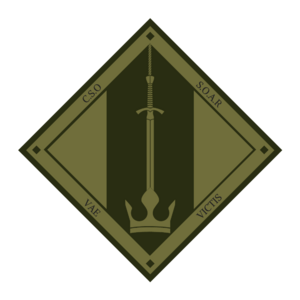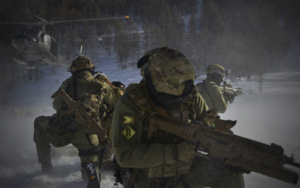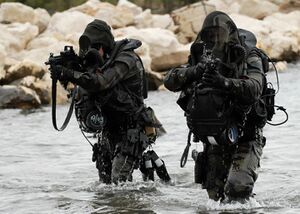Special Operations and Aggressive Reconnaissance
| Special Operations and Aggressive Reconnaissance Brigade | |
|---|---|
| Brigada dei Specialé Operación ét Agressivé Reconocimiento | |
 SOAR insignia, known as the "Sword of Damocles" | |
| Active | 12 September 1941 – present (82 years, 11 months) |
| Country | |
| Type | Special operations force |
| Role | Special operations Direct action Counter-terrorism Aggressive reconnaissance (Recce-in-force) Unconventional Warfare Hostage rescue Foreign internal defense Counter-proliferation |
| Part of | Special Operations Command (Iverica) Joint Special Warfare Division |
| Garrison/HQ | Site Sierra, Leon Military Zone |
| Nickname(s) | "The Boys in Black", "The Men with Pointy Knives", "The Brigade" |
| Motto(s) | Vae Victis (Aroman Latin) |
| Engagements |
|
The Brigada dei Specialé Operación ét Agressivé Reconocimiento (Anglish: Special Operations and Aggressive Reconnaissance Brigade), more popularly known as SOAR is the Republic of Iverica's direct action special forces unit. The brigade is activated in response to national security, hostage, or wartime scenarios which require the fielding of a unit experienced in multiple forms of insertion, fieldcraft, the operation of special weaponry, and other special skills. The unit undertakes several roles including covert reconnaissance, counter-terrorism, direct action and hostage rescue. Much of the information and actions regarding the SOAR is highly classified and is considered sensitive information by members of the Iverican government.
The SOAR is part of the Republican Armed Service- Special Operations Command (SOC), a separate entity under the direct command of the Júnt-Capos or "Joint-Leaders" of the Armed Service. SOC is not considered a "branch" of the armed service, but a special division with a separate administration, leadership, and protocol.
The SOAR brigade consists of an estimated 2000 servicemen and women divided into three battalions, each of which may act independently of the others. Historically, the unit has been known to carry out covert intelligence gathering, sabotage, aggressive reconaissance (reconnaissance-in-force), counter-insurgency, hostage rescue, and the eliminiation or capture of enemy high-value targets.
History
The SOAR Brigade traces its origins to 1941, in response to the rise of Slavic and Nordic militant groups in Iverica's central and northern Argic holdings. An incident known as the Weliky Massacre, in which 32 Ivericans were killed in a remote region of Korelio, prompted the formation of a quick response unit that was proficient in both advanced deployment methods and small-unit tactics. In the next 6-months, the Executive Ministry legitimised the Special Operations and Aggressive Reconnaissance Brigade, under the Iverican Army's command. It was reformed as part of the Special Operations Command in 1954 after the post-Argic War reforms mandated the creation of a special administrative body with the competence to oversee the management and deployment of special warfare units. The brigade would gain fame and recognition worldwide after its televised rescue of all but two of the hostages held during the 1974 Iverican Embassy Siege in Vilvau.
Argic Wars
During the Argic Wars, SOAR's numbers were swelled by the necessity of the total war theatre around Argis. In 1951 it was officially composed of 9 Battalions with a total of 6,000 personnel. Acting occasionally as saboteurs and more frequently as a covert vanguard or mobile flanking force, the Argic Wars would be the first and only time SOAR would engage the enemy as a front-line fighting force. Despite this, SOAR was involved in numerous covert operations in smaller strengths. Notably, Operation Clipépapel (Clipped Paper) during the closing stages of the war in 1954. SOAR teams, in conjunction with defecting Central Argic officers orchestrated and carried out a simultaneous raid on Central Argic Power research and development sites. As a result, vital intelligence of weapons and technological data was seized by the SOAR. Furthermore, more than 32 scientists and engineers of note were arrested and extradited to Iverica.
Vasqqan Civil Wars
Due to the sensitive ethnic nature of the Vasqqan conflicts, the SOAR adopted more covert methods of operation, many times working in conjunction with the Special Security Office to undermine Narvic nationalist groups in Vasqqa and Narva. Many raid operations were kept classified from public access for decades, out of the volatility of the tensions between Vasqqan Creoles and Vasqqan-Narvics. During these conflicts, the SOAR was known to work in small teams of 4-8, often mimicking the cells of insurgent organisations in structure. Plainclothes operations were common, and the SOAR has been suspect to partaking or executing false-flag operations against non-insurgent, pro-Narvic political dissident groups.
Mediargic Missile Crisis
The proliferation of conventional and CBRN rated missile technology within the Argic Slavosphere and Nordosphere raised many concerns within the Iverican government. As events escalated to the deployment of Helleno-Russian SRBMs in the Mediargic Sea area, SOAR was covertly and proactively deployed in Girkmand to set up a listening post and Forward Operating Base. In 1967, SOAR conducted a Visit Board Search and Seize (VBSS) operation on the Helleno-Russian tanker Smolenskaya and proved the existence of unsafe chemical weapons shipped via a false-flag civilian tanker. The international exposure led to trade pressure on Hellenic Rus and eventually led to the de-escalation and removal of missile weapons in the Mediargic.
Operation Ultra Violet
Officially known as O-PLAN Ultra Violet. SOAR was deployed in Afropa in 2017 to aid coalition forces in search and destroy operations targetting Violetists Liberation Army weapon stockpiles. Working with Iverican Navy Tercio units, SOAR consultants participated in 18 raids on weapons, narcotics, and IED manufactuing sites.
Operation Paloma
On December 13, 2017, Primo Franso Deitorr licensed a rescue operation to evacuate some 200 civilians and embassy staff trapped in Moskovo, Ahrana--then undergoing a takeover coup by Communist-led forces. on 0400 IST, SOAR was deployed alongside the Iverican Air Force. Air Force fighter flights, taking off from Custo D'Orient airport, Galicia enforced a no-fly zone along an air-corridor leading to Moskova International Airport. Flybys covered SOAR units as they inserted via C-9 Toro transports and enforced an Iverican perimeter within 1 airport runway and an adjacent terminal. Motorised units were quickly deployed to ferry civilians from the embassy building to the airport. Operation Paloma was reportedly bloodless with no casualties reported among Ahranians nor Ivericans.
Operation Wolfhound
On March 12, 2021 [1], 2 SOAR platoons from the 2nd Battalion conducted pathfinding and intereference operations for the liberation of Estaria from Sentist forces under the command of the Northern Sentist Alliance general identified by the Special Security Office as Harrison Wolfe—then using the alias "Commandant Wolf". The 2 platoons were critical to the execution of operations behind enemy lines, assisting irregular Estarian resistance fighters, surveying ground for airborne parachute operations, and assisting in the capture of the Estaria National Hydroelectric Dam.
Operation Whaler
On 0312 Quest (Quebec) Time, February 2, 2022 [2], 3 teams of SOAR operators from the 3rd Battalion executed a Visit, Board, Search, and Seizure operation on the Suverine cargo ship MV Rezina, which was then under suspicion of transporting Ballistic Missile parts to Koudiland, in breach of the Goodwill Accords. 1 SOAR operator was reported killed-in-action and 5 more were wounded when the heavily armed crew opened fire with automatic rifles. The Iverican Ministry of Foreign Affairs later released photographs of the Rezina's cargo. After-action reports detailed that the corpses of at least 7 civilians were found on the ship with the probably cause of death being gunshot wounds to the head at close range. Forensic investigation later released by the Ministry of Foreign Affairs determined the executions to have been carried out by members of the crew. Documentation of several missile parts including solid-fuel propellant and rocket motors.
Organisation
The brigade currently consists of the 1st, 2nd, and 3rd SOAR Battalions, which are structured similarly to one-battalion regiments in that they are expected to be capable of executing their main roles without extensive support.
The brigade falls under the Special Operations Command (SOC), an administrative entity outside of the RAS's regular chain of command. The SOC falls under the direct command of the Joint-Leaders of the Armed Service and can be called into action directly by the Capo-Comandante. Within the SOC, the brigade falls under the Joint Special Warfare Division, one of 4 divisions in the SOC which specifically organises units or operations employing personnel from different branches.
Battalions
The SO/AR brigade is divided into 3 battalions. Each battalion is self-supporting and self-reliant given special support services and access to equipment that is typically present only at the Division-level in conventional branch units. Though battalion command and supply is compartmentalised for maximum flexibility, cooperation between two or even all three is not uncommon.
Each battalion has approx. 600 personnel active, sans support staff. They are again divided into 6 companies of 100 personnel each. Each company is divided into platoons which can operate in smaller sections or fireteams of 5--following the common unit structures.
Overall command of the brigade rests with the Júnt Capos (Joint Chiefs) but strategic command is given to a General (OF-8 or 9). Subordinate to the General are 3 Teniente Coronels (Lieutenant Colonels) who command each of the battalions and oversee operations command. Each platoon is then commanded by a Teniente (Lieutenant) and each operator will typically hold the rank of Decano Primo (Lance Corporal).
SO/AR battalions are typically assigned to an Amphibious Assault Ship or Amphibious Transport Dock which serves as a dedicated mobile headquarters. Onboard these vessels are the special vehicles, equipment, and dedicated support staff prepared for any possible deployment. Small SOAR units are also known to operate on Iverican Navy submarines and can infiltrate an area of operations by diving action or by midget submarine.
Training
Selection & Assessment
Passing a Selection & Assessment or Curso dei Selección ét Evaluación (S&E) stage is a prerequisite for every SOAR applicant. It is a 19-day course and is one of the most grueling selection processes in the Republican Armed Service. The multiweek course is run by the Cadre dei Specialé Operación at Campo Mavro near the Site Sierra, in the province of Léon. The course is designed to predict successful completion of the SOAR Qualification Course and utilises an individual-focused assessment process to profile an applicant's physical and mental capacities. Applications for the S&E course are limited to active-duty personnel who have completed some form of basic training from any branch of the RAS and must be para-jump qualified. Applicants must be at least 17 years of age and no more than 40 years of age.
The S&E evaluates candidates against job-related dimensions specific to the SOAR and the operational environments in which they serve. The evaluations are written, verbal, and practical tests which derive questionnaires, and live hands-on problem solving challenges from Special Operations Command models evaluating the events of SOC unit operations in the last 40 years. The assessment process is both performance- and behavior-based. Cadre officers observe and record observable aspects of the applicant's problem solving process. Further assessments takes place during the a teamwork phase. The teamwork phase is designed to stress applicants and produce observable and measurable behaviors for later evaluation. The measurements are applied towards a whole-individual profile used to assess and select SOAR candidates holistically.
Towards the end of the course, a 7-day recess period is allowed for the Cadre officers to evaluate the collected data. Suitability to attend the next qualification course is determined by assessing the applicant's ability throughout the S&E on the attributes of intelligence, physical fitness, motivation, trainability, judgment and influence. At the end of the program, a board meets to select those applicants most qualified to attend the qualification course. At this juncture, a passing applicant may take a leave from the SOAR candidacy process for duty or personal reasons. Their passability is valid for 24 months from the time of successful board selection.
The RAS reports that applicants who pass the S&E are, on average, within or above the 80th percentile of the RAS serviceperson population in terms of mental compentencies, above the 60th percentile in terms of physical condition, and above the 70th percentile in terms of communication competency.
Qualification
Following successful completion of the S&E process selected applicants are addressed as candidates. They will be scheduled to attend the SOAR Curso-QS or Curso Qualificacióne Especialé in Campo Verde, North Aigüestoré. Curso-QS focuses on core Special Operations Command tactical competencies in support of surgical strike and special warfare; Survival, Evasion, Resistance and Escape (SERE); language proficiency; and regional cultural understanding. The qualification course consists of six sequential phases of training.
PHASE ALBA: COURSE ORIENTATION AND HISTORY (6 weeks)
The Orientation Course is a six-week introduction to Special Forces, covering history, doctrine, organization, command and control, core tasks and mission, Special Forces attributes, Special Forces mission planning, geographic literacy (including terrain identification, cartographic literacy, navigational competence, etc.), introduction to small-unit tactics, physical fitness and nutrition, a para-jumpp refresher, and participation in a Force-on-Force exercise against other RAS units, taking on the OPFOR personas of a guerrilla force.
PHASE ÁMBAR: SMALL-UNIT TACTICS (SUT) (13 weeks)
Phase II of the QS includes an in-depth study of and practicum related to small-unit tactics and operations. It provides the tactical combat skills required to operate successfully on a Compania Primera or COI-1a (SOAR Battalion primary combat formation). Candidates will master the following tactical skills: basic and advanced combat rifle marksmanship, small-unit tactics, SOC common tasks, urban warfare operations, SOC mission analysis, Advanced Special Operations Fieldcraft, sensitive site exploitation procedures, military decision-making process, Tactical Operations Orders, and advanced SERE training.
PHASE VERMELL: MOS TRAINING (14 Weeks)
Each candidate attending the QS is assigned to one of five Occupational Specialties for SOC personnel. For officers: Special Forces Leadership, Special Forces Weapons, Special Forces Engineer, Special Forces Medical, or Special Forces Communications.
PHASE GRANATÉ: UNCONVENTIONAL WARFARE CULMINATION EXERCISE (4 weeks)
Candidates must put to use all of the skills they have learned throughout the QS to navigate the unconventional warfare environment successfully during their Force-on-Force exercise. These exercises have serve as a critical elimination period for candidates and their evaluating cadre. Candidates are organized into Company Teams or Platoon Teams mirroring the COI-1a. The COI-1a is trained and mentored throughout the exercise, from mission receipt through planning and infiltration, by combat-proven Special Forces operators. Candidates are taught the necessary skills to survive and succeed in a UW environment consisting of a notional country characterized by political instability and armed conflict that forces candidates to exercise both individual and collective problem-solving. A key to the success of the Robin Sage training is its real-world feel that is established by the use of guerrilla forces. The COI-1a must assess the combat effectiveness of the G-forces and then train them in basic individual tasks from each of the MOSs as well as collective tasks in basic small-unit tactics, while remaining responsive to asymmetrical challenges. During this training, the COI-1a must demonstrate its knowledge of unconventional warfare doctrine and operational techniques. Participating in this rigorous and realistic training exercise provides the future SOAR operator with the skills and confidence needed to successfully deploy with an COI-1a.
PHASE GRIS: LANGUAGE AND CULTURE (24 weeks)
Phase V of the QS focuses on language and culture. During Phase V, candidates receive basic special operations language training in the language assigned to them at the completion of S&E. Languages are broken into two categories based on their degree of difficulty.
PHASE SABÉL: GRADUATION (1 week)
Phase VI is the final phase and is comprised of one week of outprocessing, where candidates don their earned SOAR accoutrements for the graduation ceremony. Ceremonial items include: a black beret, a black aiguillette,a cap badge, a pair of collar pins, a pair of cufflinks, the Special Operations Command Tab, and the SOAR Birgade Patch. The badges, links, pins, and patches show the distinct "Sword of Damocles" device in varying forms. A ceremonial long Rondel dagger with a short length of snapped cord tied to its pommel is issued at the close of the ceremony.
Further Training
Equipment
SOAR units have access to a greater variety of weaponry and equipment than regular units in the RAS. Equipment can vary between Battalions and between Companies. However, Brigade command is responsible for evaluating and clearing all unconventional or personal-use equipment employed by operators, ensuring that some safety, sustainment, and quality standards are maintained.
Small Arms
As of 2022, Brigade units are issued AGP-210 rifles in various configurations. the AGP-210 platform are chambered in 6.8x43 mm SPC and are gas-piston rifles in the conventional layout (magazine ahead of grip). Most units utilise the AGP-210S, carbine variant with a 13-inch barrel, polymer stock, handguard, and lower receiver. Compared to most AGP-210 variants, the S-variant has more picatinny rail space for external attachments like laser devices, optics, underbarrel, and ergonimic peripherals.
Most SOAR operators are issued with a Spano Arms P-38S or P-41 chambered in 9x22 SS.
SOAR units in low-visibility operations in civilian or public spaces will often elect to use local or common weaponry. Operators often train to be as proficient with common enemy weapons as they are with their own issued weapons. The Varinco vz. 58 rifle and the Gluck 9x19 mm pistols are often maintained by SOAR quartermasters.

